|
Compound Action Potential |
Conduction velocity>
Difference and Absolute methods |
| |
The objective of this part of the lab is to measure the
conduction velocity of several groups of fibres in the nerve, using two different methods. |
|
|
|
|
|
|
|
The variation in conduction velocity in the
various fibres in the nerve is an important factor in determining the shape of the
Compound Action Potential, since the conduction velocity of each
fibre determines the
latency of its contribution to the CAP. Conduction
velocity is systematically related to fibre diameter in fibres of a given type. In
myelinated frog nerve fibres, the relationship is approximately:
Velocity
(m/s) = Diameter (Ámeters) x 2.5
The conduction velocity of nerve is normally reported in
meters per second. It is more easily recorded as millimeters per millisecond, which
yields the same result. |
|
|
|
Procedure: the
difference method |
|
|
The stimulus duration is set to 0.2 ms, and two
pair of
recording leads are connected similar to the example below: |
|
|
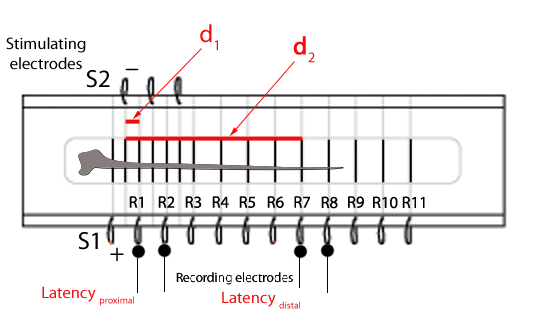 |
|
A maximal CAP is elicited, and the latencies (in ms) to the peaks of the
responses are measured. This latency signifies the time it took for average fibres in the
nerve to transmit their APs from the stimulating electrodes to the
first recording electrode.
|
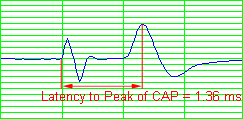
Recording from Channel A
(proximal electrode R1) |
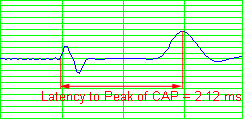
Recording from Channel B
(distal
electrode R7) |
|
|
|
In order to calculate a velocity
measurement, we need a time and a distance measurement. Now if we
subtract the latency determined proximally from the latency
determined distally, we are getting a value for the time it took
for the CAP to travel from electrode R1 to electrode R7. |
|
Conduction velocity
(difference method)
= (d2-d1)/(latencydistal - latencyproximal) |
|
In summary, to calculate the
conduction velocity by the Difference Method, we must take latency measurements using two
different recording positions. The conduction distance is the distance between the first
recording electrode for each position, and the conduction time is the difference between
the latencies at the first recording electrode for each position. |
|
|
|
Procedure: the
absolute method |
|
|
The conduction velocity can also be
calculated by the absolute method, which means that the velocity is calculated using a
single latency and distance measurement. Here we will calculate the absolute
velocity at electrode R1. |
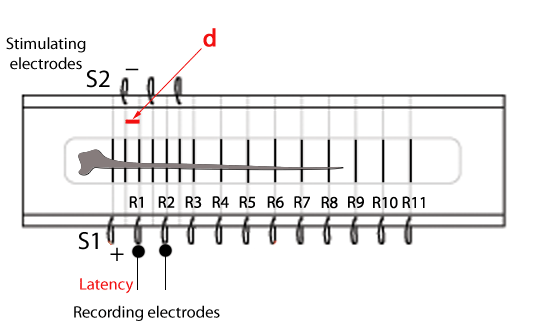 |
|
In this case, we will need to measure the
absolute distance travelled. In the sample bath to the right, we measure
from the
cathode (the stimulating electrode nearest the recording electrodes) to the first
recording electrode R1 |
|
Latency = latency at
electrode R1 (ms)
d = distance (mm) from stimulating electrode to recording electrode
R1
Velocity = d /
latency (m/s) or (mm/ms) |
|
|
One can also calculate the velocity for
electrode R7: the same formula applies except that the distance d and
the latency are of course longer. |
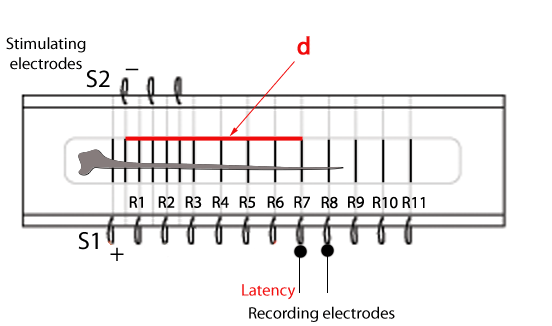 |
|
|
|
Q: How do the absolute
and difference methods for calculating velocity compare? What errors are involved in
determining velocity with the frog sciatic nerve preparation?
A: By using the difference method, you subtract out any
"uncertainties" involved in the measurement of latencies. For example, if
we are uncertain as to where the AP's are actually originating within the vicinity of the
stimulating electrodes, this "error" will be introduced into both latency
measurements, and therefore subtracted out when performing a difference method
calculation. However, the difference method is only experimentally sound when one is
dealing with the same population of nerve fibres over the recording electrodes used, which
is not the case with the sciatic nerve, as it is a short nerve, and thin at one end.
The non-uniformity of the nerve, and the difficulty in
making accurate measurements of very small distances and latencies are principal points to
consider when making conduction velocity measurements. Naturally if the nerve studied were
longer and more uniform, we would improve the accuracy of our calculations.Q: Could we just as easily have measured
velocities by taking a latency measurement to the peak of the negative phase of the CAP
(instead of to the peak of the positive phase)?
A: We could do
the measurement using the peak of the negative phase of the CAP, but the negative phase is
often smaller, overlapping with the positive phase, thus making measurements more
difficult. If we did measure the latency at the negative phase, it would be a latency
corresponding to the second recording electrode, and distance measurements would
then have to be taken accordingly. |
|
Click here to continue with the topic of conduction
velocity (a-alpha and A-beta fibres) |
|
|
|